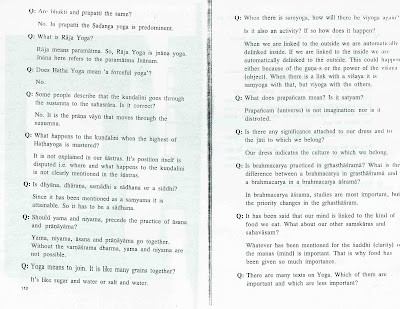from Yogacarya Krishnamacharya - The Purnacarya. Edited by Mala Srivatsan
The first biography of Krishnamacharya
Unfortunately long out of print
"Q: What does the bhakti mean to a person who has no belief in Isvara?
Krishnamacharya: Love is bhakti for them".
------------------------
The questions.
1. What is Yogasana?
2. What is the role of the mantra in asana practice?
3. What should the duration of pranava be during recitation?
4. What is the first step in dhyana for a beginner?
5. At what age can one start practicing yogasanas?
6. How many asanas are there?
7. Can everybody do all of the asana's?
8. Should asana vary according to age?
9. Can a person practice yogasana using photographs?
10. How many times should one practice yogasana's?
11. How long should a person stay in an asana every day?
12. How long were the sages practicing yoga?
13. What must form an essential part of a person's daily practice?
14. What should be done when there is limited time available for practice?
15. When can one see the results of practice?
16. What should be the ratio of practice between asana, pranayama and dhyana?
17. Should the asana practice be done fast and why not?
18. What does jitasana (asana jay am) mean?
19. What is meant by jitsvasam?
20. How long should one stay in Sirsasana and Sarvangasana?
21. Is there a difference in the practice for men and women?
22. How should very obese people and pregnant womnen be taught?
23. What about the practice for women after child birth?
24. What is yoga?
25. How many kinds of Yoga are there?
26. Who is competent to the practice the yogabhyasa?
27. What is yogabyasa krama?
28. What is the procedure one follows for yoga?
29. Why is there the division of hatha-yoga and raja-yoga?
30.On what basis do we follow the practice of yogasana?
40. Is there any relation between the approach to sickness in Nathamuni's school and Ayurveda?
41. Is it possible to learn pratyahara and antaranga sadhana from a teacher?
42. How many kinds of vinyasa's are there?
43. There seems to be identical verses in Sivasamhita, Gherenda Samhita and hatha yoga pradipka. Does it mean they are all based on the same text or did they have a common teacher?
44. Which is the most important yoga text today?
45. Are the techniques like viloma pranayama, anuloma pranayama, pratiloma pranayama, the different asanas and vinyasas that we use mentioned in any adhara grant (text)? or does it follow a guru parampara?
46. How are the texts like Goraksa Samhita and the Hathayoga pradipka compare with the approach of the Yoga Sutra?
47. Why should one do vaidika-sastriya karma?
48. Why should there be upasana of the devata?
49. But this becomes kamayam. is it desirable?
50. What is dharma? Please explain in simple terms.
51. Thare are many approaches to the word 'Yoga', Which of these have to be refuted?
52. What is Adarmika yoga?
53. Where in the Yoga Sutra is the Sadanga yoga of nathamuni mentioned?
54. What is the evidence that bhakti alone leads to multi?
55. What does the bhakti mean to a person who has no belief in Isvara?
56. What is the difference between prakrti and prapancam?
57. Prakrti that has guns-s is mentioned as acaitanyam. haow is this?
58. How can there be a samyoga between the prakrti, paramatma and the jivatma?
59. What is Jnana yoga?
60. Are bhakti and prapatti the same?
61. What is Raja yoga?
62. Does Hatha yoga mean a forceful yoga?
63. Some people describe that the kundalini goes through the susumna to the sahasrara. is it correct?
64. What happens to the kundalini when the highest of hathayoga is mastered?
65. Is dhyana, dharana, samadhi a sadhana or a siddhi?
66. Should yama and niyama, precede the practice of asana and pranayama?
67. Yoga means to join. It is like many grains together?
68. When there is samyoga, how will there be viniyoga again? Is it also an activity? If so how does it happen?
69. What does prapancam mean? is it sat yam?
70. Is there any significance attached to our dress and to the sati to which we belong?
71. Is brahmacarya practiced in grhasthasrama? What is the difference between a brahmacarya in grathasrama and a brahmacarya in a brahmacarya asrama?
72. It has been said that our mind is linked to the kind of food we eat. What about our other samaras and sahavasam?
73. There are many texts on Yoga. Which of them are important and which are less important?
74. Where is the evidence that Visnu is sattvika devam, siva rajasika devam and sakti tamasika devam?
75. How is it that we are able to understand the suksma visaya that has been mentioned in the sastras?
76. What is the difference between sa-guna and nir-guna?
77. What is your message to humanity?
The Answers










7 comments:
Thank you so much for sharing such a lost treasure
Thank you very much! I cannot find pages 100-103, am I missing something?
Looks like it mixed up the order and didn't upload a page, will sort it out when i get home in a couple of hours time, sorry. grimmly
thank you!! gracias Grimmly!
All fixed Kecskeméti, all the pages and in the right order.
Thank you for sharing. Truly a great resource.
Thank you very much for the sharing!
Post a Comment
Note: only a member of this blog may post a comment.